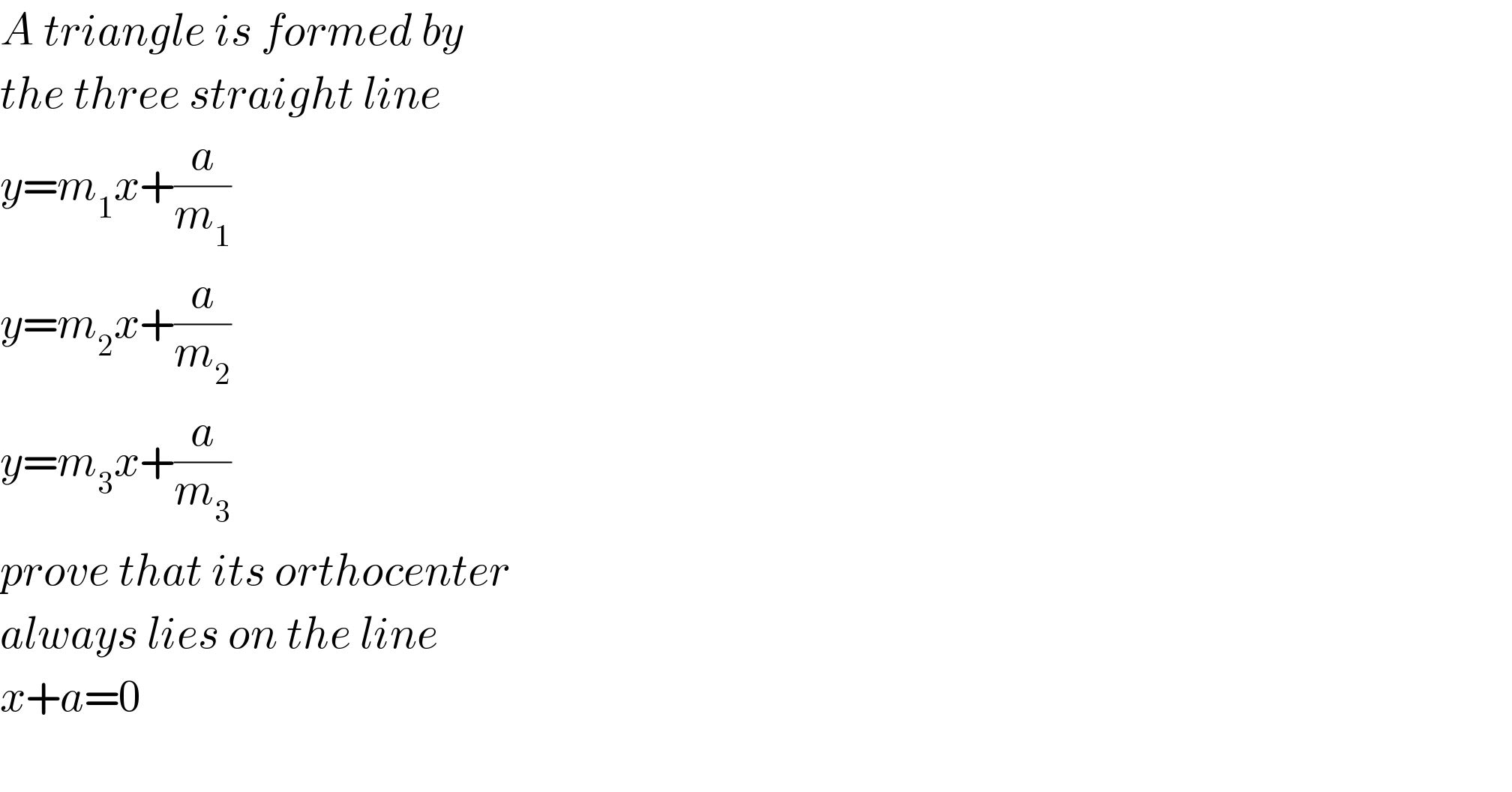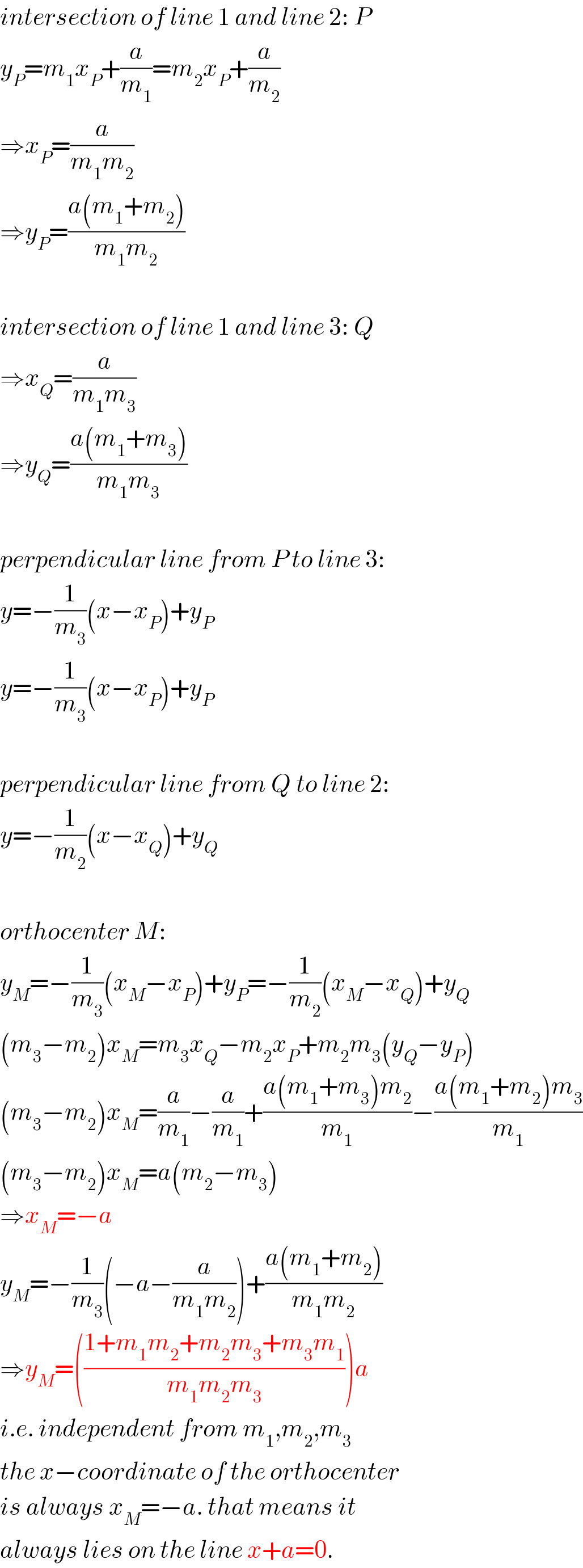Question Number 76717 by peter frank last updated on 29/Dec/19

$${A}\:{triangle}\:{is}\:{formed}\:{by} \\ $$$${the}\:{three}\:{straight}\:{line} \\ $$$${y}={m}_{\mathrm{1}} {x}+\frac{{a}}{{m}_{\mathrm{1}} } \\ $$$${y}={m}_{\mathrm{2}} {x}+\frac{{a}}{{m}_{\mathrm{2}} } \\ $$$${y}={m}_{\mathrm{3}} {x}+\frac{{a}}{{m}_{\mathrm{3}} } \\ $$$${prove}\:{that}\:{its}\:{orthocenter} \\ $$$${always}\:{lies}\:{on}\:{the}\:{line} \\ $$$${x}+{a}=\mathrm{0} \\ $$$$ \\ $$
Answered by mr W last updated on 30/Dec/19

$${intersection}\:{of}\:{line}\:\mathrm{1}\:{and}\:{line}\:\mathrm{2}:\:{P} \\ $$$${y}_{{P}} ={m}_{\mathrm{1}} {x}_{{P}} +\frac{{a}}{{m}_{\mathrm{1}} }={m}_{\mathrm{2}} {x}_{{P}} +\frac{{a}}{{m}_{\mathrm{2}} } \\ $$$$\Rightarrow{x}_{{P}} =\frac{{a}}{{m}_{\mathrm{1}} {m}_{\mathrm{2}} } \\ $$$$\Rightarrow{y}_{{P}} =\frac{{a}\left({m}_{\mathrm{1}} +{m}_{\mathrm{2}} \right)}{{m}_{\mathrm{1}} {m}_{\mathrm{2}} } \\ $$$$ \\ $$$${intersection}\:{of}\:{line}\:\mathrm{1}\:{and}\:{line}\:\mathrm{3}:\:{Q} \\ $$$$\Rightarrow{x}_{{Q}} =\frac{{a}}{{m}_{\mathrm{1}} {m}_{\mathrm{3}} } \\ $$$$\Rightarrow{y}_{{Q}} =\frac{{a}\left({m}_{\mathrm{1}} +{m}_{\mathrm{3}} \right)}{{m}_{\mathrm{1}} {m}_{\mathrm{3}} } \\ $$$$ \\ $$$${perpendicular}\:{line}\:{from}\:{P}\:{to}\:{line}\:\mathrm{3}: \\ $$$${y}=−\frac{\mathrm{1}}{{m}_{\mathrm{3}} }\left({x}−{x}_{{P}} \right)+{y}_{{P}} \\ $$$${y}=−\frac{\mathrm{1}}{{m}_{\mathrm{3}} }\left({x}−{x}_{{P}} \right)+{y}_{{P}} \\ $$$$ \\ $$$${perpendicular}\:{line}\:{from}\:{Q}\:{to}\:{line}\:\mathrm{2}: \\ $$$${y}=−\frac{\mathrm{1}}{{m}_{\mathrm{2}} }\left({x}−{x}_{{Q}} \right)+{y}_{{Q}} \\ $$$$ \\ $$$${orthocenter}\:{M}: \\ $$$${y}_{{M}} =−\frac{\mathrm{1}}{{m}_{\mathrm{3}} }\left({x}_{{M}} −{x}_{{P}} \right)+{y}_{{P}} =−\frac{\mathrm{1}}{{m}_{\mathrm{2}} }\left({x}_{{M}} −{x}_{{Q}} \right)+{y}_{{Q}} \\ $$$$\left({m}_{\mathrm{3}} −{m}_{\mathrm{2}} \right){x}_{{M}} ={m}_{\mathrm{3}} {x}_{{Q}} −{m}_{\mathrm{2}} {x}_{{P}} +{m}_{\mathrm{2}} {m}_{\mathrm{3}} \left({y}_{{Q}} −{y}_{{P}} \right) \\ $$$$\left({m}_{\mathrm{3}} −{m}_{\mathrm{2}} \right){x}_{{M}} =\frac{{a}}{{m}_{\mathrm{1}} }−\frac{{a}}{{m}_{\mathrm{1}} }+\frac{{a}\left({m}_{\mathrm{1}} +{m}_{\mathrm{3}} \right){m}_{\mathrm{2}} }{{m}_{\mathrm{1}} }−\frac{{a}\left({m}_{\mathrm{1}} +{m}_{\mathrm{2}} \right){m}_{\mathrm{3}} }{{m}_{\mathrm{1}} } \\ $$$$\left({m}_{\mathrm{3}} −{m}_{\mathrm{2}} \right){x}_{{M}} ={a}\left({m}_{\mathrm{2}} −{m}_{\mathrm{3}} \right) \\ $$$$\Rightarrow{x}_{{M}} =−{a} \\ $$$${y}_{{M}} =−\frac{\mathrm{1}}{{m}_{\mathrm{3}} }\left(−{a}−\frac{{a}}{{m}_{\mathrm{1}} {m}_{\mathrm{2}} }\right)+\frac{{a}\left({m}_{\mathrm{1}} +{m}_{\mathrm{2}} \right)}{{m}_{\mathrm{1}} {m}_{\mathrm{2}} } \\ $$$$\Rightarrow{y}_{{M}} =\left(\frac{\mathrm{1}+{m}_{\mathrm{1}} {m}_{\mathrm{2}} +{m}_{\mathrm{2}} {m}_{\mathrm{3}} +{m}_{\mathrm{3}} {m}_{\mathrm{1}} }{{m}_{\mathrm{1}} {m}_{\mathrm{2}} {m}_{\mathrm{3}} }\right){a} \\ $$$${i}.{e}.\:{independent}\:{from}\:{m}_{\mathrm{1}} ,{m}_{\mathrm{2}} ,{m}_{\mathrm{3}} \\ $$$${the}\:{x}−{coordinate}\:{of}\:{the}\:{orthocenter}\: \\ $$$${is}\:{always}\:{x}_{{M}} =−{a}.\:{that}\:{means}\:{it} \\ $$$${always}\:{lies}\:{on}\:{the}\:{line}\:{x}+{a}=\mathrm{0}. \\ $$
Commented by peter frank last updated on 30/Dec/19

$${GODBLESS}\:{YOU} \\ $$
